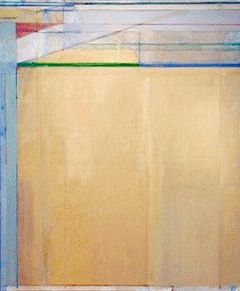- Richard Diebenkorn
-
Richard Diebenkorn 
Ocean Park No.129, oil on canvas, 1984Born April 22, 1922
Portland, OregonDied March 30, 1993 (aged 70)
Berkeley, CaliforniaNationality American Field Painting Movement Bay Area Figurative Movement, Abstract Expressionism, Color Field painting, Lyrical Abstraction Influenced by Edward Hopper, Willem de Kooning, Clyfford Still, Arshile Gorky, Henri Matisse Influenced Bay Area Figurative School  Richard Diebenkorn, Cityscape I,(Landscape No. 1), 1963, Oil on canvas, 60¼ × 50½ in, San Francisco Museum of Modern Art.
Richard Diebenkorn, Cityscape I,(Landscape No. 1), 1963, Oil on canvas, 60¼ × 50½ in, San Francisco Museum of Modern Art.
Richard Diebenkorn (April 22, 1922 – March 30, 1993) was a well-known 20th century American painter. His early work is associated with Abstract expressionism and the Bay Area Figurative Movement of the 1950s and 1960s. His later work (best known as the Ocean Park paintings) were instrumental to his achievement of worldwide acclaim.
Contents
Biography
Richard Clifford Diebenkorn Jr. was born on April 22, 1922 in Portland, Oregon. His family moved to San Francisco, California, when he was two years old. From the age of four or five he was continually drawing.[1] In 1940, Diebenkorn entered Stanford University, where he met his first two artistic mentors, Professor Victor Arnautoff who guided Diebenkorn in classical formal discipline with oil paint, and Daniel Mendelowitz, with whom he shared a passion for the work of Edward Hopper.[2] Hopper's influence can be seen in Diebenkorn's representational work of this time.
During the late 1940s and early 1950s, he lived and worked in various places: New York City, Woodstock, New York, Albuquerque, New Mexico, Urbana, Illinois and Berkeley, California. He developed his own style of abstract expressionist painting. Abstract expressionism had captured worldwide attention, having developed in New York during the 1940s.
Diebenkorn served in the United States Marine Corps from 1943 to 1945.[3] After the Second World War, the focus of the art world shifted from the School of Paris to the New York School. In the early 1950s, Diebenkorn adopted abstract expressionism as his vehicle for self-expression, influenced at first by Clyfford Still, Arshile Gorky, Hassel Smith and Willem de Kooning. He became a leading abstract expressionist on the west coast. In 1950 to 1952, Diebenkorn was enrolled under the G.I. Bill in the University of New Mexico’s graduate fine-arts department where he created a lucid version of Abstract Expressionism.[4]
He lived in Berkeley, California, from 1955 to 1966. By the mid-1950s, Diebenkorn had become an important figurative painter, in a style that bridged Henri Matisse with abstract expressionism. Diebenkorn, Elmer Bischoff, Henry Villierme, David Park, James Weeks and others participated in a renaissance of figurative painting, dubbed the Bay Area Figurative Movement.
From fall 1964 to spring 1965, Diebenkorn traveled through Europe and he was granted a cultural visa to visit important Soviet museums and view their holdings of Matisse's paintings. When he returned to painting in the Bay Area in mid-1965, his resulting works summed up all that he had learned from more than a decade as a leading figurative painter.[5]
In 1967, Diebenkorn returned to abstraction, this time in a distinctly personal, geometric style that clearly departed from his early abstract expressionist period. The "Ocean Park" series, begun in 1967 and developed for over twenty-five years, became his most famous work and resulted in more than 140 paintings. Based on the aerial landscape and perhaps the view from the window of his studio, these large-scale abstract compositions are named after a community in Santa Monica, California, where he had his studio. The Ocean Park series bridges his earlier abstract expressionist works with Color field painting and Lyrical Abstraction. He taught at this time at UCLA. In 1990, Diebenkorn produced a series of six etchings for the Arion Press edition of Poems of W. B. Yeats, with poems selected and introduced by Helen Vendler. In 1991, he was awarded the National Medal of Arts.[6]
Richard Diebenkorn died due to complications from emphysema in Berkeley on March 30, 1993.
See also
- Abstract expressionism
- Color field painting
- Lyrical Abstraction
- Western painting
- History of painting
References
- ^ Livingston, J: "The Art of Richard Diebenkorn", page 18. Whitney California, 1997.
- ^ Livingston, J: "The Art of Richard Diebenkorn", pages 20–21. Whitney California, 1997.
- ^ "RD Biography". Richard Diebenkorn Catalogue Raisonné. http://www.diebenkorn.org/bio/bio.html. Retrieved March 21, 2009.
- ^ Robert Ayers (January 3, 2008). New York Winter Exhibition Preview. ARTINFO. http://www.artinfo.com/news/story/26357/new-york-winter-exhibition-preview/. Retrieved 2008-04-24
- ^ Jane Livingston, The Art of Richard Diebenkorn, p.56, 1997–1998 Exhibition catalog, The Whitney Museum of American Art, The Art of Richard Diebenkorn, ISBN 0-52021257-6,
- ^ Lifetime Honors - National Medal of Arts
Sources
- Jane Livingston, The Art of Richard Diebenkorn, with essays by John Elderfield, Ruth E. Fine, and Jane Livingston. The Whitney Museum of American Art, 1997, ISBN 0-520-21257-6
- Marika Herskovic, American Abstract Expressionism of the 1950s An Illustrated Survey, (New York School Press, 2003.) ISBN 0-9677994-1-4. p. 102-105
- Marika Herskovic, American Abstract and Figurative Expressionism: Style Is Timely Art Is Timeless. (New York School Press, 2009.) ISBN 9780967799421. p. 80-83
External links
- Richard Diebenkorn Catalogue Raisonné
- Richarddiebenkorn.net
- Richard Diebenkorn Artwork Examples on AskART.
- NY Times obituary
Further reading
- Nancy Marmer, "Richard Diebenkorn: Pacific Extensions," Art in America, January/February 1978, pp. 95–99.
Categories:- 1922 births
- 1993 deaths
- Stanford University alumni
- Abstract expressionist artists
- American painters
- American printmakers
- Artists from California
- Modern painters
- San Francisco Art Institute alumni
- Contemporary painters
- People from Portland, Oregon
Wikimedia Foundation. 2010.

